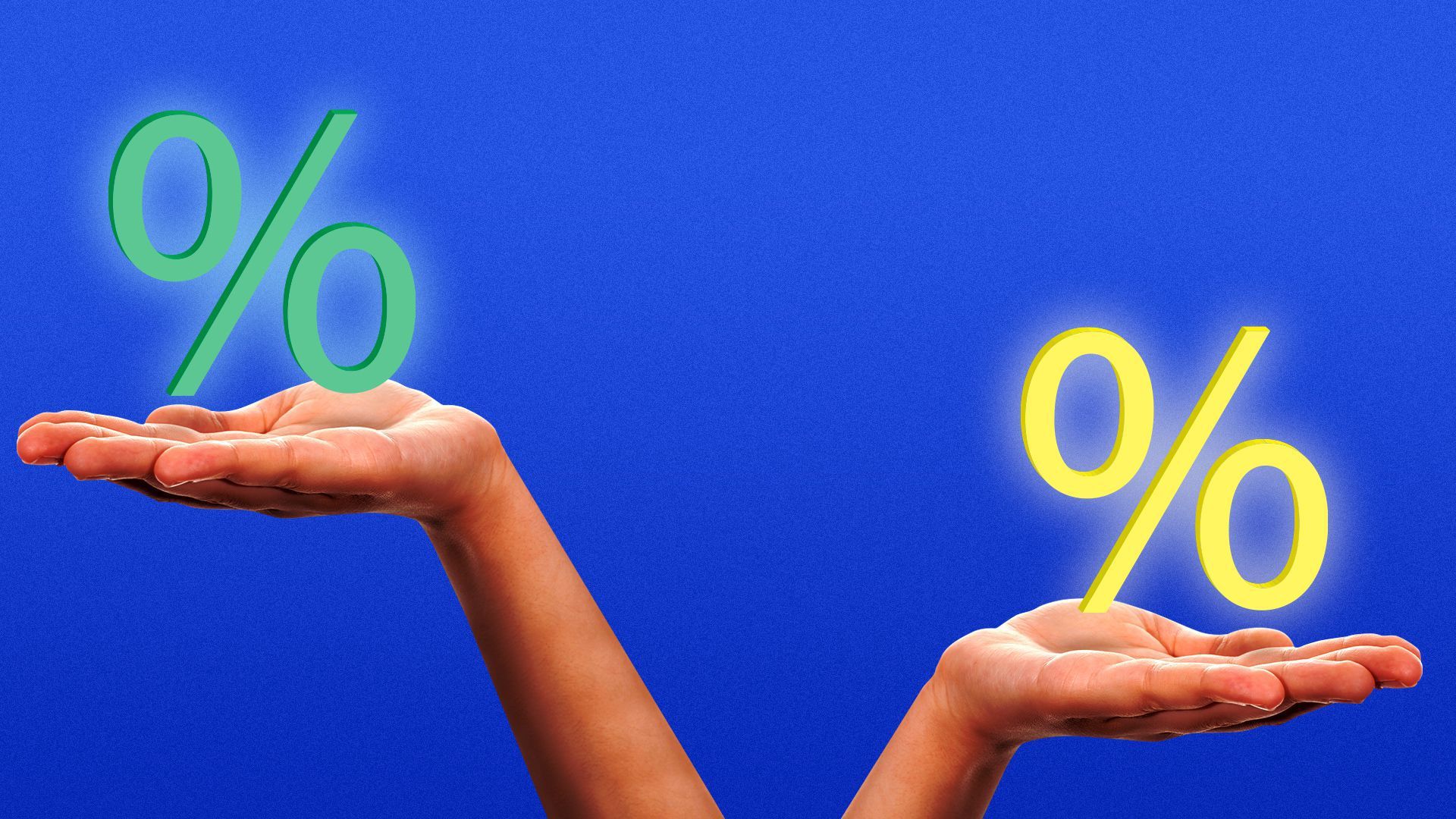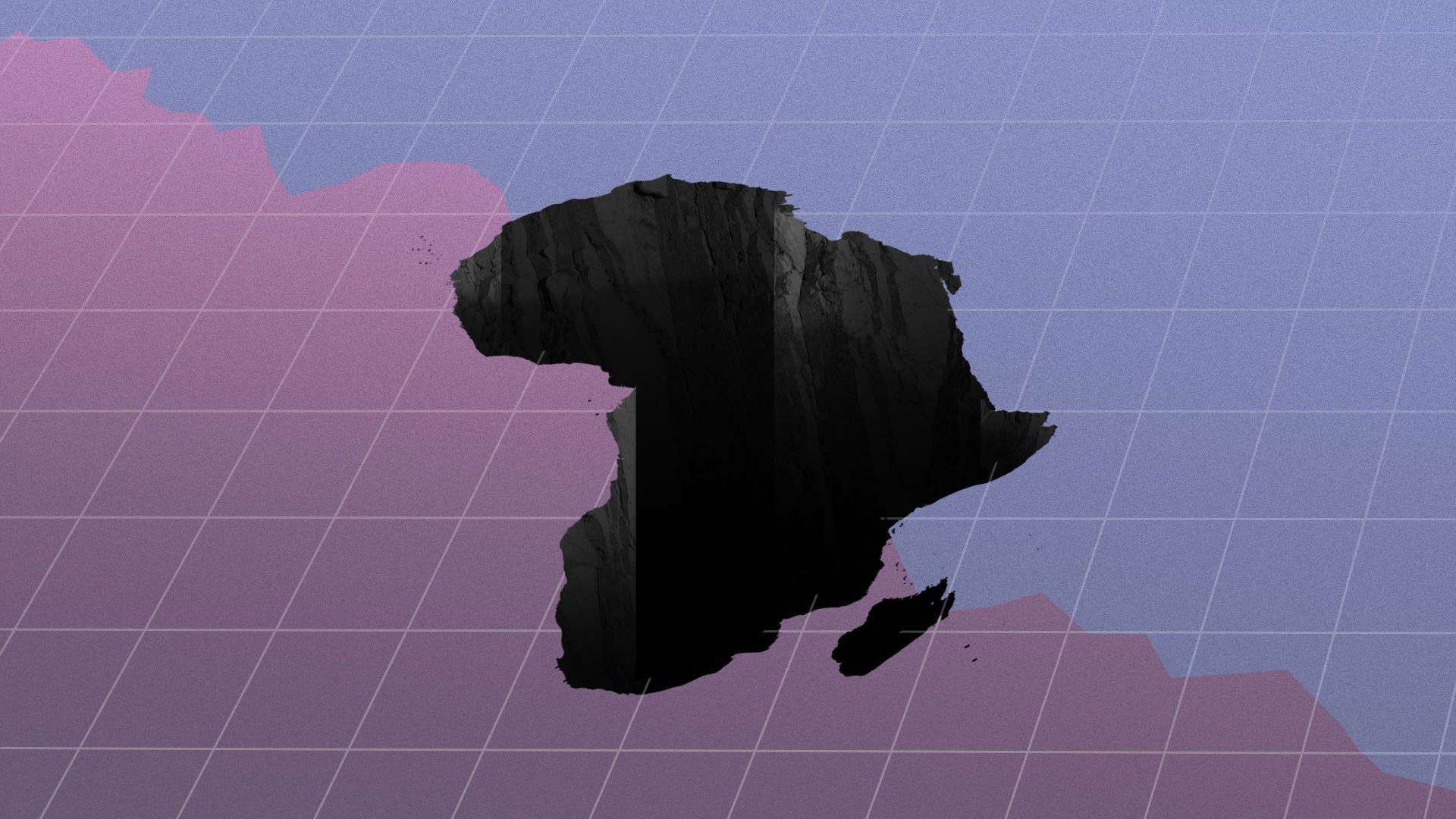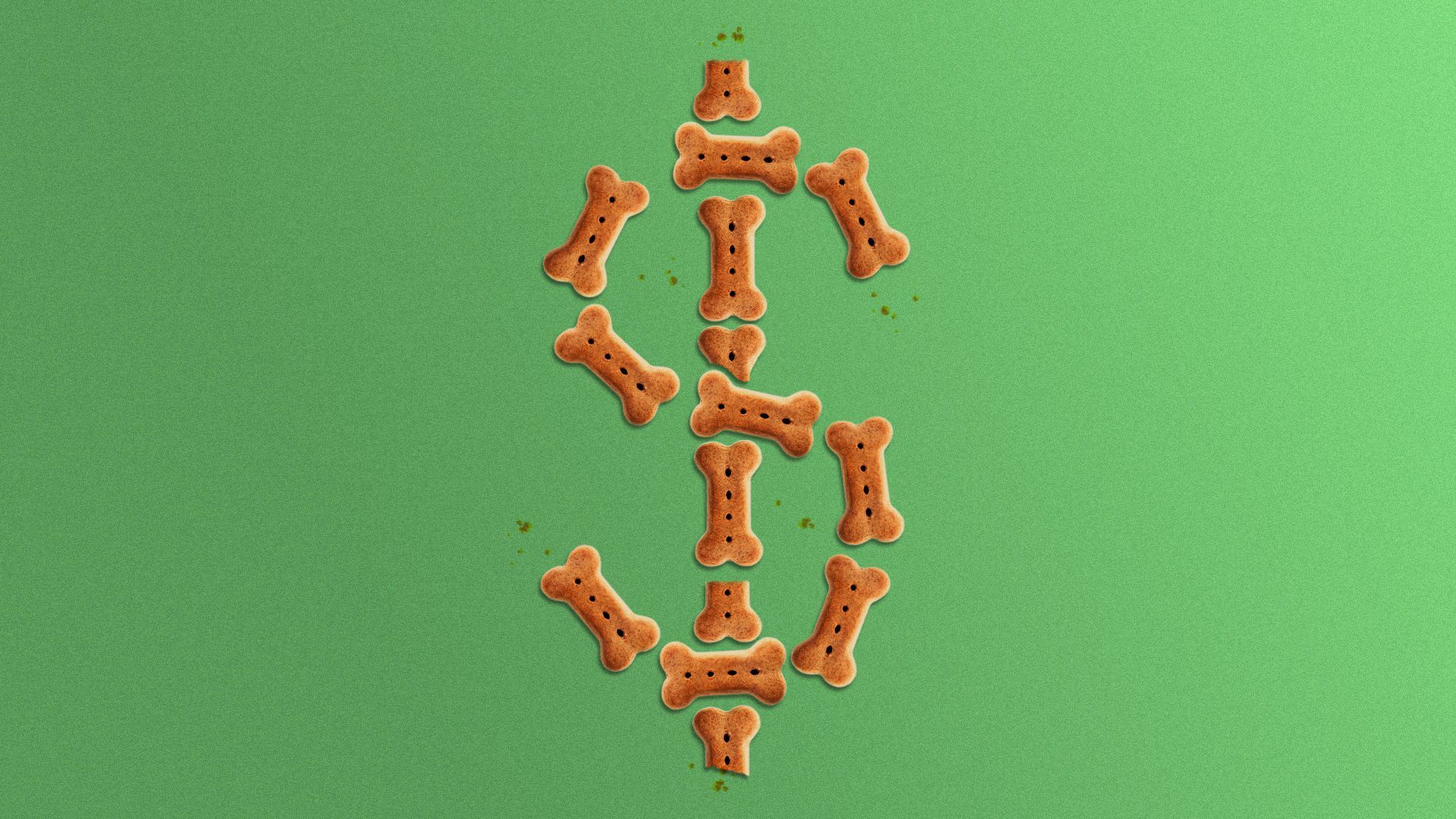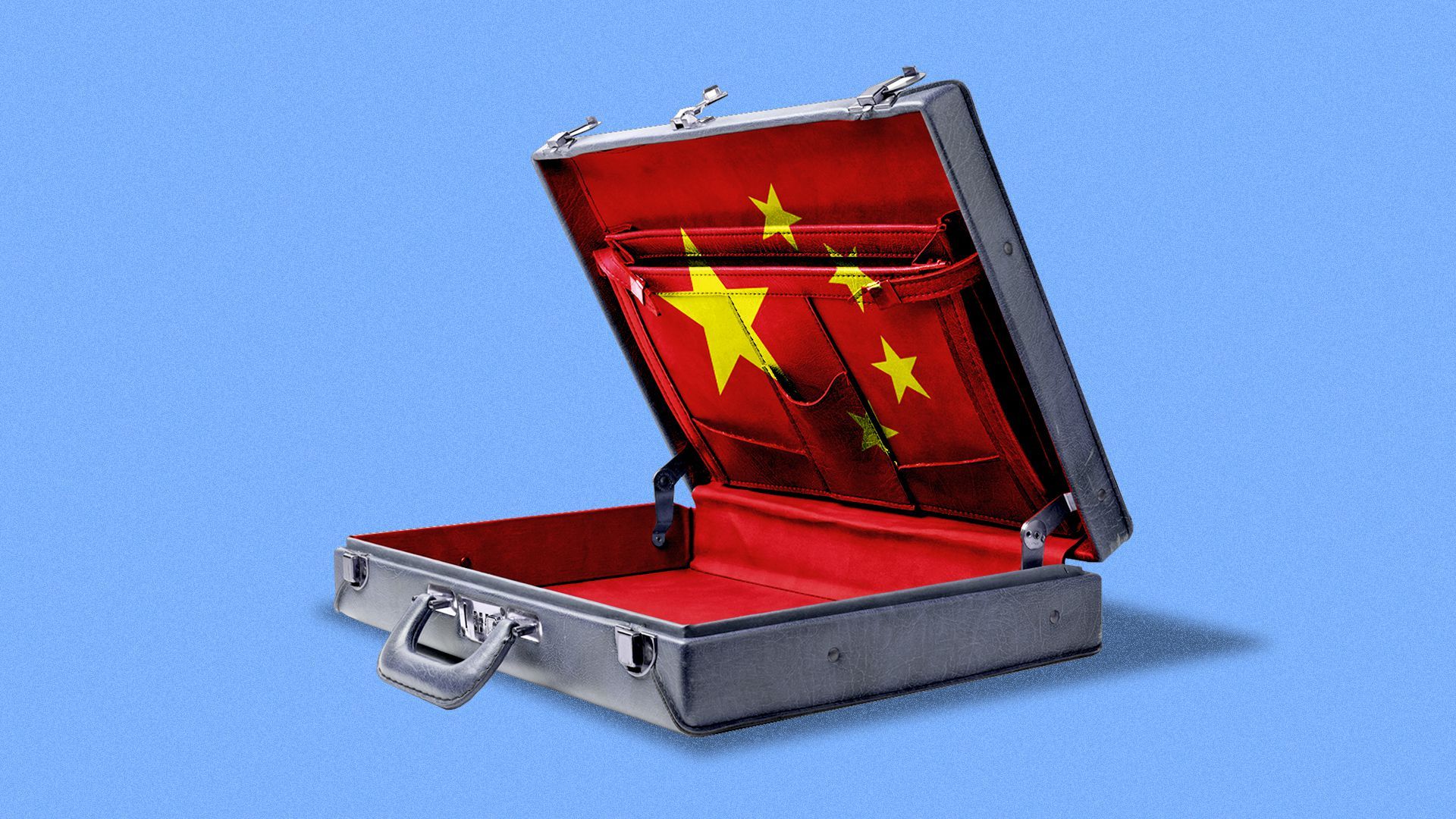| | | | | | | Axios Capital | | By Felix Salmon ·Oct 29, 2020 | | Situational awareness: State-owned Turkish bank Halkbank faced a multi-billion-dollar fine for violating U.S. sanctions by dealing with Iran. Then Trump got involved — along with Treasury Secretary Steven Mnuchin. - In this week's newsletter: A GDP report for the ages; how dual interest rates can save the world; Africa's funding gap; PetSmart loses Chewy; Google's app rebrand; an unusual Sotheby's auction; and much more. All in 1,732 words, a 7-minute read.
| | | | | | 1 big thing: The recovery begins |  Data: BEA; Chart: Danielle Alberti/Axios If you wanted proof that the recession is over, it arrived this morning with the release of a stunning 33.1% annualized growth rate last quarter. - If you wanted proof that we're still in a hole of historic proportions, that arrived, too. Per University of Michigan economist Justin Wolfers, the economy is roughly as far below its peak as it was in the darkest days of the last recession.
By the numbers: GDP peaked in the fourth quarter of 2019, when it hit an annualized rate of $19.25 trillion (measured in 2012 dollars). - The current level — $18.58 trillion — is still well below pre-pandemic levels.
The big picture: GDP is normally one of the most predictable and slow-moving economic indicators, and a quarterly cadence makes sense. This year, however, we're really feeling the need for some kind of monthly GDP series. - The third-quarter rise in GDP reflects a bounce from the depths of the shutdown in April, and could easily hide very sluggish growth in September.
- Current data, meanwhile, indicate that growth might have flatlined in October.
The bottom line: It's easy to think of entire industries, from travel to entertainment to urban commercial real estate, that are still effectively shut down. - The only way we'll get back to pre-pandemic levels of economic activity is to get a real grip on the pandemic. With cases at an all-time high, that isn't happening.
Go deeper: U.S. economy sees record growth in third quarter |     | | | | | | 2. How central banks can save the world |  | | | Illustration: Aïda Amer/Axios | | | | The trillion-dollar gap between actual GDP and potential GDP is a gap made up of misery, unemployment, and unfulfilled promise. It's also a gap that can be eradicated — if central banks embrace unconventional monetary policy. - That's the message from Eric Lonergan and Megan Greene, two economists who reject the idea that central banks have hit a "lower bound" on interest rates. In fact, they reject the idea that "interest rates" are a singular thing at all, and they fullthroatedly reject the idea — most recently put forward by New York Fed president Bill Dudley — that the Fed is "out of firepower."
Why it matters: If Lonergan and Greene are right, then central banks have effectively unlimited ammunition in their fight to increase inflation and employment. They are limited only by political will. How it works: Historically, central banks have borrowed and lent at pretty much the same interest rate. But that doesn't have to be the case. - In Europe, the central bank, the ECB, is now lending money to banks at a -1% interest rate. That's significantly lower than the rate it pays on those banks' reserves.
- European banks can't just borrow the money and put it on deposit at the central bank. They only get the loans if they turn around and re-lend them into the real economy — and their regulator, the European Banking Authority, makes sure that they do exactly that.
In the U.S., the Fed could do something similar. It could reduce the discount rate — the rate at which banks borrow money from the central bank — to, say, -3%, while still keeping the Fed Funds rate in positive territory. - Savers would still be able to get positive returns on their deposits, but borrowers could effectively be paid to borrow money.
- The deeply discounted loans to the banks would be contingent on the banks taking that money and re-lending it into targeted areas of the economy, rather than speculating with it or using it to fund things like mortgages.
Be smart: By targeting the loans, a dual interest rate policy could turbocharge government efforts to, say, build a carbon-neutral economy. My thought bubble: Such a policy looks — and is — very close to fiscal policy, rather than monetary policy. It violates the principle that central banks are politically independent. But the Fed is already working hand-in-glove with Treasury. And given political constraints on extra spending from Congress, it makes sense to find that money at the Fed instead. Go deeper: Lonergan and Greene explain their proposal in detail in a fantastic episode of the "Macro Musings" podcast. |     | | | | | | 3. Africa loses economic hope |  | | | Illustration: Sarah Grillo/Axios | | | | The good news is that most of Africa has done surprisingly well in terms of COVID-19 cases and deaths. - The bad news is that the pandemic has greatly exacerbated a continent-wide economic crisis. Even before the virus hit, Africa was suffering from weak commodity prices and a devastating plague of locusts.
Why it matters: There's not remotely enough money to help finance the needed recovery. The big picture: The pandemic has killed far more Americans (225,000) than Africans (41,000), despite the fact that Africa has a much larger population. - The U.S. might be behind epidemiologically, but it has a huge advantage economically. Like other rich virus-hit countries in Europe, it can respond to the crisis by borrowing as much money as it needs.
- African countries, by contrast, have lost their market access, and one of them — Zambia — has already defaulted on its bonds as a result.
 Data: Dealogic; Chart: Andrew Witherspoon/Axios By the numbers: Zero sub-Saharan African countries have managed to issue an international bond since the crisis hit, according to data from Dealogic. - Rich nations, by contrast, painlessly issued 288 bonds with a combined value of more than $430 billion in just the second and third quarters of this year. Those countries — the 37 members of the Organization for Economic Co-operation and Development — are paying roughly 0% interest on the money they're borrowing, and using it to rebuild their economies.
Between the lines: There is some funding available for sub-Saharan African countries. Nigeria, Ivory Coast and South Africa all managed to borrow in their local currencies, and the International Monetary Fund has lent $26 billion in emergency funding to the continent. Still, IMF managing director Kristalina Georgieva estimates that Africa has an eye-popping funding gap of $345 billion between now and 2023. - The lack of money means a lack of growth: The IMF forecasts that Africa will grow by just 3% in 2021. That's well below the expected global growth rate of 5.2%.
- Georgieva has begged her counterparts at the World Bank, where she was previously CEO, to provide grants to needy African countries.
- An analysis from the Center for Global Development found that the World Bank has moved more slowly this year than it did during the global financial crisis, even as global poverty rates rise alarmingly.
The bottom line: More than 60% of Africa's population is under the age of 25. That has helped keep the death rate low, even if some individual countries' COVID-19 statistics are unreliable. - 1.2 billion Africans don't just need to live, however; they also need economic hope. And that, currently, seems further away than it has done in years.
|     | | | | | | 4. PetSmart loses its crown jewel |  | | | Illustration: Aïda Amer/Axios | | | | When a deeply indebted brick-and-mortar retailer spends billions of dollars on a buzzy e-commerce startup, the story rarely ends well. PetSmart's 2017 acquisition of Chewy.com, however, would seem to be the exception. - PetSmart spent $3.35 billion on Chewy; that investment today is now valued by the stock market at more than $29 billion.
- Even after losing some of its stake last year, PetSmart still owns more than enough of Chewy to pay off PetSmart's existing $2.7 billion in debt and leave the company as one of a very few healthy, solidly profitable retailers that can compete and win against Amazon.
Why it matters: PetSmart is ... not doing that. Instead, its owner, BC Partners, is ripping Chewy out of PetSmart's hands entirely, leaving PetSmart with $2.3 billion in debt and a B2 credit rating from Moody's that keeps it solidly in junk-bond territory. What they're saying: "I risk exposure to the virus every single day and barely earn enough for basic necessities like rent, food, and healthcare," says Christian Hopkins, a PetSmart employee in Winston-Salem, North Carolina, who complains that he isn't being provided with adequate personal protective equipment. "Meanwhile BC Partners is cashing out with $11 billion in profit." Flashback: The 2012 presidential election was dominated by questions about whether companies really benefit when they're acquired by private equity companies like BC Partners or Mitt Romney's Bain Capital. The bottom line: This deal makes PetSmart look like little more than a financial asset to be engineered by its private-equity owners. Understandably, that doesn't go down well with the retailer's minimum-wage employees. |     | | | | | | Bonus: The rise and rise of Chewy |  Data: FactSet; Chart: Axios Visuals |     | | | | | | 5. Rebrand of the week |  | | | Logos: Google | | | | You've probably noticed some of your most-used apps have gone chubby in recent weeks. - The culprit: Google, which has rebranded G Suite as Google Workspace and in doing so has rolled out a whole new set of logos.
What they're saying: The new logos "represent Google Workspace's commitment to building immersive communication and collaboration experiences," according to the official press release. - The other side: "Senseless ... ugly ... little rainbow blobs ... they don't really have colors. They all have all the colors, which just right off the bat makes it harder to tell them apart ... their shapes are bad ... makes the Drive logo look like a biohazard symbol." — Devin Coldewey, Techcrunch
The bottom line: Most of us were perfectly happy thinking of these apps, especially Gmail, as being entirely separate from each other. Google doesn't want us to do that, which is why Gmail's elegant envelope visual pun has now been eradicated. |     | | | | | | 6. Auction of the week |  | | | Photo via Sotheby's | | | | Grande femme I, a nine-foot tall sculpture made by Alberto Giacometti in 1960 for Chase Manhattan Plaza in New York, sold at auction this week. Why it matters: Weirdly, Sotheby's, which ran the auction, isn't revealing how much it sold for — just that it was more than the minimum bid of $90 million. - The auction was run not by the auction side of Sotheby's, but rather by the private sale side. Sealed bids were submitted to an outside auditor, who determined the winner.
The big picture: Any time that more than one buyer is interested in an artwork, there is some kind of auction. It's rare for private sellers to be this explicit about the mechanism, but if anybody can do it, Sotheby's can. - Once consignors realize that they can get all the benefit of an auction without having to reveal how much money they're receiving, expect an increasing number of these opaque transactions — and even less public data on exactly how much money is sloshing around the art world.
|     | | | | | | 7. Coming up: Ant Group goes public |  | | | Illustration: Annelise Capossela/Axios | | | | Ant Group, the financial services giant spun off from Alibaba, becomes a publicly traded company in China next Thursday. Why it matters: It's expected to be the largest IPO of all time, shattering the previous record held by Saudi Aramco. (Which itself narrowly bested the previous mark set by Alibaba.) - Ant won't list its shares in the U.S. Instead, the company will dual-list shares in Hong Kong and Shanghai.
- It's set to raise $34.4 billion, putting it alongside the world's most valuable banks.
|     | | | | | | 8. Building of the week: Longhouse, NYC |  | | | Photo: Ernesto Roman | | | | NeueHouse is a co-working space and member's club in New York, which is obviously struggling during the pandemic. - Its solution to the social-distancing problem is Longhouse, a flexible narrow space on the Madison Square sidewalk that can be used for working, eating, or meeting. It can even lend itself to live performances.
- Designed by BVN architects, the structure is made of plywood that was originally used to cover up shop windows during the Black Lives Matter protests.
|     | | | | Thanks for subscribing to this free newsletter! Tell your friends they should do so too; the sign-up link is here. | | | | Axios thanks our partners for supporting our newsletters.
Sponsorship has no influence on editorial content. Axios, 3100 Clarendon Blvd, Suite 1300, Arlington VA 22201 | | | You received this email because you signed up for newsletters from Axios.
Change your preferences or unsubscribe here. | | | Was this email forwarded to you?
Sign up now to get Axios in your inbox. | | | | Follow Axios on social media:    | | | | | |













No comments:
Post a Comment